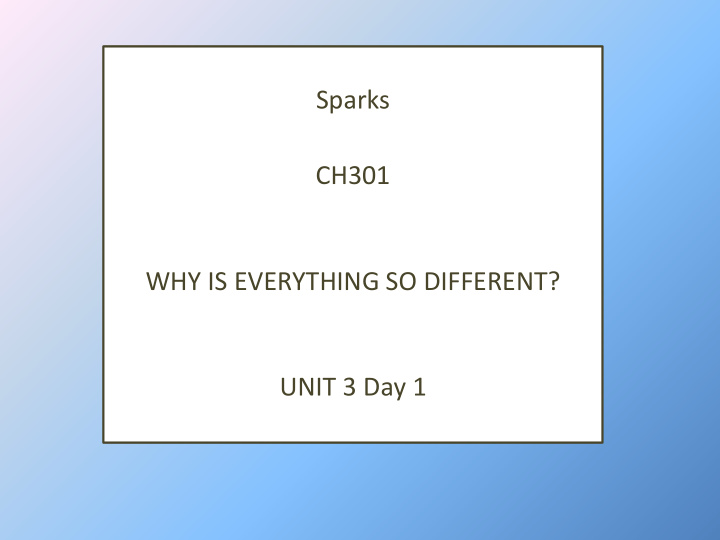



Sparks CH301 WHY IS EVERYTHING SO DIFFERENT? UNIT 3 Day 1
What are we going to learn today? Think about why matter is so diverse Attractive and Repulsive Electrostatic Forces Dipole Moment
POLL: CLICKER QUESTION Matter is diverse implies all of the following, EXCEPT: a) The same type of matter can exist in different phases b) Different types of matter exist in different phases at the same temperature c) Compounds exhibit different characteristic properties based on the type of elements that compose that compound d) All matter is composed of the same fundamental building blocks
Work individually for 10 minutes to complete the worksheet PLEASE DO NOT TALK DURING THIS TIME WE WILL BE COLLECTING THESE WORKSHEETS!
Look Around -Find three different types of matter -Obvious that matter is diverse. Scientists have worked hard to develop models to explain and predict the various forms of matter. -What is an important factor in different types of matter being different?
Electrons are Important Electrostatic Attractions and Repulsions - Forces that dominate on the molecular scale Can we get some electrons from somewhere and see for ourselves? Play with Scotch tape
Press your tape down on your desk as indicated. Gently peel the B and T tape up off the base, keeping the pieces together. When directed rip the two pieces of tape apart. Don’t touch the tape to anything. Slowly bring the two pieces together. Observe Slowly bring a B tape near a neighbor’s B tape. Observe. Charge a balloon. Bring each tape near the balloon to see what happens.
POLL: CLICKER QUESTION Based on your observation of the tape: a) The bottom is negatively charged b) The top is negatively charged c) It is impossible to tell which is negative
Can you attract a liquid with a charged object? TRY IT!
MOLECULES CAN CARRY A WEAK CHARGE THE GREATER THE CHARGE THE STRONGER THE ATTRACTION TO THE CHARGED ROD! WHAT CAN YOU INFER FROM THE BURET EXPERIMENT CONCERNING THE RELATIVE CHARGE ON THE LIQUIDS?
Electrons are not always equally shared Electronegativty: Some atoms of elements have a stronger attraction for electrons than others Equal attraction – pure covalent Intermediate situation – polar covalent Characterize bonding more quantitatively using a dipole moment measurement
Electronegativity
DIPOLE MOMENT μ μ = Q d +q Q = charge in coulombs d = distance separating charges -q electron charge = -1.60 x 10 -19 C Units: Debye (D) 1 D = 3.336 10 – 30 (C x m)
DIPOLE MOMENTS OF SOME COMMON COMPOUNDS HF 1.83 D HBr 0.8 D NaCl 9.0 D (gas phase)
POLL: CLICKER QUESTION Given the following dipole moments: HF 1.83 D HBr 0.8 D NaCl 9.0 D (gas phase) Which of the following is a good guess for the dipole moment of HI? a) 0.4 D b) 1.4 D c) 2.4 D d) 4.0 D
Dipole Moment GUESS THE DIPOLE MOMENT OF O=C=O
POLL: CLICKER QUESTION If the dipole moment of CH 3 Cl is 1.87 Guess the dipole moment for: CCl 4
What have we learned? Electrostatic Forces Dominate on the Molecular Level We have observed Electrostatic Forces Solids/Liquids/Gases – Something to do with the Forces Depending on how the electrons are dispersed in a bond, may or may not be polar Shape matters
Learning Outcomes Recognize that matter is diverse and the condensed phases of matter will vary based on composition Identify polar bonds Understand the concept of the bond and a dipole Define dipole moment
Recommend
More recommend